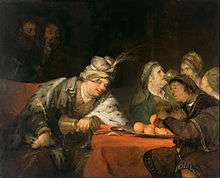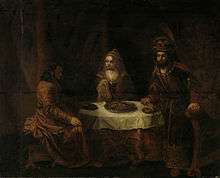Ahasuerus


Ahasuerus (Hebrew: אֲחַשְׁוֵרוֹשׁ, Modern ʼAḥašvērōš, Tiberian ʼAẖašwērōš; Greek: Ασουηρος, translit. Asouēros in the Septuagint; or Latin: Assuerus in the Vulgate; commonly transliterated Achashverosh; cf. Old Persian: 𐎧𐏁𐎹𐎠𐎼𐏁𐎠, translit. 𐎧𐏁𐎹𐎠𐎼𐏁𐎠 Xšayārša; Persian: اخشورش Axšoreš; Ancient Greek: Ξέρξης, translit. Xerxes) is a name used several times in the Hebrew Bible, as well as related legends and Apocrypha. This name (or title) is applied in the Hebrew Scriptures to three rulers. The same name is also applied uncertainly to a Babylonian official (or Median king) noted in the Book of Tobit.
Etymology


The original name was Old Persian Xšayārša. This became Babylonian Aḥšiyaršu (𒄴𒅆𒐊𒅈𒋗, aḫ-ši-ia-ar-šu), then becoming Akšiwaršu (𒀝𒅆𒄿𒈠𒅈𒍪, ak-ši-i-wa6-ar-šu), borrowed into Hebrew as אחשורוש ʼĂḥašəwērôš, and thence into Latin as Ahasuerus, the form traditionally used in English Bibles.[1][2]
The Persian name was independently rendered in Ancient Greek as Ξέρξης Xérxēs. Many newer English translations and paraphrases of the Bible[3] have used the name Xerxes.
Biblical references
Book of Esther

Ahasuerus is given as the name of the King of Persia in the Book of Esther.[4]
Historical identification
Numerous scholars have proposed theories as to who Ahasuerus represents. Most scholars generally identify him with Xerxes I of Persia, as did 19th-century Bible commentaries.[5] Four factors, among others, contribute to this identification:
1. It is agreed the Hebrew 'Ahasuerus' descended from the Persian names for Xerxes I. Additionally, the form of the king's name written in Esther 10:1, ’aḥašērōš (Hebrew: אֲחַשֵׁרֹשׁ) bears much more resemblance to the original old Persian Xšayārša than the standard Hebrew form which does not omit the word’s vavim.
2. Herodotus mentions Xerxes I having a particular affinity for women and wine, as well as mentioning the king ruled from India to Ethiopia in a magnificent palace in Shusan, all of which the Book of Esther corroborates. Herodotus also mentions that Xerxes I sought comfort in his harem following his defeat at Salamis in the tenth month of his seventh year as king, which is strikingly similar to the date of Ahasuerus choosing beautiful women from his harem in the tenth month of his seventh year as king (Esther 2:16).
3. Annals from the reign of Xerxes I mention an otherwise unattested official by the name of "Marduka", which some have proposed refers to Mordecai, as both are mentioned serving in the king's court.
4. Chapter 4 of the Book of Ezra mentions Xerxes I imposing sanctions on the Jewish people, which some see as support of Haman's decree.
However, the Septuagint, the Vulgate, the Midrash of Esther Rabbah, I, 3 and the Josippon identify the king as Artaxerxes, and the historian Josephus relates that this was the name by which he was known to the Greeks.[6] The Ethiopic text calls him Arťeksis, usually the Ethiopic equivalent of Artaxerxes. John of Ephesus and Bar-Hebraeus identified him as Artaxerxes II, a view strongly supported by the 20th century scholar Jacob Hoschander.[7] Masudi recorded the Persian view of events which affirms the identification and al-Tabari similarly placed the events during the time of Artaxerxes II despite being confused by the Hebrew name for the king. Esther Rabba and the Vulgate present "Ahasuerus" as a different name for the king to "Artaxerxes" rather than an equivalent in different languages, and the Septuagint distinguished between the two names using a Greek transliteration of Ahasuerus for occurrences outside the Book of Esther. Indeed, an inscription from the time of Artaxerxes II records that he was also known as Arshu understood to be a shortening of the Babylonian form Achshiyarshu derived from the Persian Khshayarsha (Xerxes). The Greek historians Ctesias and Deinon noted that Artaxerxes II was also called Arsicas or Oarses respectively similarly understood to be derived from Khshayarsha, the former as the shortened form together with the Persian suffix -ke applied to such shortened names.[7]
On his accession however Artaxerxes II lost Egypt to pharaoh Amyrtaeus after which it wasn't part of the Persian empire anymore. In his Historia Scholastica Petrus Comestor identified Ahasuerus (Esther 1:1) as Artaxerxes III who reconquered Egypt.[8]
Book of Ezra
Ahasuerus is also given as the name of a King of Persia in the Book of Ezra.[9] Modern commentators associate him with Xerxes I who reigned from 486 BC until 465 BC. Other identifications have been made for Cambyses II[10] or with Bardiya (Greek Smerdis) who reigned (perhaps as an imposter) for seven months between Cambyses II and Darius I.[11]
However the Elephantine papyri mention the high priest Johanan as a contemporary of Darius II.[12][13] Furthermore, in the book of Ezra, Ahasuerus follows king Darius (Ezra 6:1), while Johanan (Ezra 10:6) is mentioned as (grand)son (Nehemiah 12:22) of the high priest at the time of Nehemiah, Eliashib (Nehemiah 3:1).
In Ezra 4:8 the text changes from Hebrew to Aramaic, therefore the king's name in Ezra 4:7, also used in the following letter, possibly is the Aramaic version of the king's name Ahasuerus mentioned in Ezra 4:6.
Book of Daniel
Ahasuerus is given as the name of the father of Darius the Mede in the Book of Daniel.[14] Josephus names Astyages as the father of Darius the Mede, and the description of the latter as uncle and father-in-law of Cyrus by mediaeval Jewish commentators matches that of Cyaxares II, who is said to be the son of Astyages by Xenophon. Thus this Ahasuerus is commonly identified with Astyages. He is alternatively identified, together with the Ahasuerus of the Book of Tobit, as Cyaxares I, said to be the father of Astyages. Views differ on how to reconcile the sources in this case. One view is that the description of Ahasuerus as the "father" of Darius the Mede should be understood in the broader sense of "forebear" or "ancestor." Another view notes that on the Behistun Inscription, "Cyaxares" is a family name, and thus considers the description as literal, viewing Astyages as an intermediate ruler wrongly placed in the family line in the Greek sources.
However, in the book of Daniel the king's title changes from 'king of the Chaldeans = Babylonians' to 'king of the Persians', which also occurred between the kingships of Darius I and Xerxes.[15] Furthermore, the 120 satraps mentioned in Daniel 6:2 can be translated as 20 tribute owing satraps through whom Darius I divided his kingdom.[16]
The "about 62 years" in Daniel 6:1 possibly refer to the distance to the destruction of the Jerusalem temple rather than the age of Darius.
Darius I did not build in Babylon or the old Persian capital Pasargadae (the centers of power of Cyrus the Great), he did build however in the old Median capital Ecbatana.[17]
Phonetically the name of Darius I's father Hystaspes closely relates to the name Astyages.
Book of Tobit
In some versions of the deuterocanonical Book of Tobit, Ahasuerus is given as the name of an associate of Nebuchadnezzar, who together with him, destroyed Nineveh just before Tobit's death.[18] A traditional Catholic view is that he is identical to the Ahasuerus of Daniel 9:1[19] In the Codex Sinaiticus Greek (LXX) edition, the two names in this verse appear instead as one name, Ahikar (also the name of another character in the story of Tobit). Other Septuagint texts have the name Achiachar. Western scholars have proposed that Achiachar is a variant form of the name "Cyaxares I of Media", who historically did destroy Nineveh, in 612 BC.
In legends
In some versions of the legend of the Wandering Jew, his true name is held to be Ahasuerus.[20] This is the name by which Immanuel Kant refers to the Wandering Jew in The Only Possible Argument in Support of a Demonstration of the Existence of God.[21]
Notes
- ↑ KJV, NASB, Amplified Bible, ESV, 21st Century King James Version, ASV, Young's Literal Translation, Darby Translation, Holman Christian Standard Bible, etc.
- ↑ Nichol, F.D., Seventh-day Adventist Bible Commentary, Volume 3, Review and Herald Publishing Association, (Washington, D.C., 1954 edition), p.459, "Historical Setting"
- ↑ NIV, The Message, NLT, CEV, NCV, NIRV, TNIV, etc.
- ↑ Esther 1
- ↑ "The Religious Policy of Xerxes and the 'Book of Esther'", Littman, Robert J., The Jewish Quarterly Review, 65.3, January 1975, p.145–148.
- ↑ Ahasuerus at the JewishEncyclopedia.com
- 1 2 Jacob Hoschander, The Book of Esther in the Light of History, Oxford University Press, 1923
- ↑ "Historia Scholastica/Esther - Wikisource". la.wikisource.org. Retrieved 17 April 2018.
- ↑ Ezra 4:5-7
- ↑ Gill's Exposition of the Whole Bible, as quoted by Bible.cc/ezra/4-7.htm
- ↑ Clarke's Commentary on the Bible, as quoted by Bible.cc/ezra/4-7.htm
- ↑ Pritchard, James B. ed., Ancient Near Eastern Texts Relating to the Old Testament, Princeton University Press, third edition with supplement 1969, p. 492
- ↑ Bezalel Porten (Author), J. J. Farber (Author), C. J. F. Martin (Author), G. Vittmann (Author), The Elephantine Papyri in English (Documenta Et Monumenta Orientis Antiqui, book 22), Koninklijke Brill NV, The Netherlands, 1996, p 125-153.
- ↑ Daniel 9:1
- ↑ Roman Ghirshman, Iran (1954), Penguin Books, p 191.
- ↑ Wilhelm Gesenius, Hebräisches und Aramäisches Handwörterbuch über das Alte Testament, 17. Auflage (1962), Springer-Verlag, p 392.
- ↑ Karl Julius Ploetz, A Handbook of Universal History from the Dawn of Civilization to the Outbreak of the Great War of 1914: Ploetz's Epitome.
- ↑ Book of Tobit, 14:15.
- ↑ Maas, Anthony (1907). Assuerus. In The Catholic Encyclopedia. New York: Robert Appleton Company. Retrieved April 15, 2009 from New Advent: http://www.newadvent.org/cathen/02005c.htm
- ↑ Andrei Oişteanu, "The legend of the wandering Jew in Europe and Romania". Archived from the original on 2008-02-03. Retrieved 2008-03-12. Studia Hebraica.
- ↑ Kant, I. Der einzig mögliche Beweisgrund zu einer Demonstration des Daseins Gottes. 1763. AA 2:76
References

External links
| Wikimedia Commons has media related to Ahasuerus. |
- McCullough, W. S. (1984). "Ahasureus". Encyclopaedia Iranica, Vol. I, Fasc. 6. pp. 634–635.
| Wikisource has the text of the 1911 Encyclopædia Britannica article Ahasuerus. |